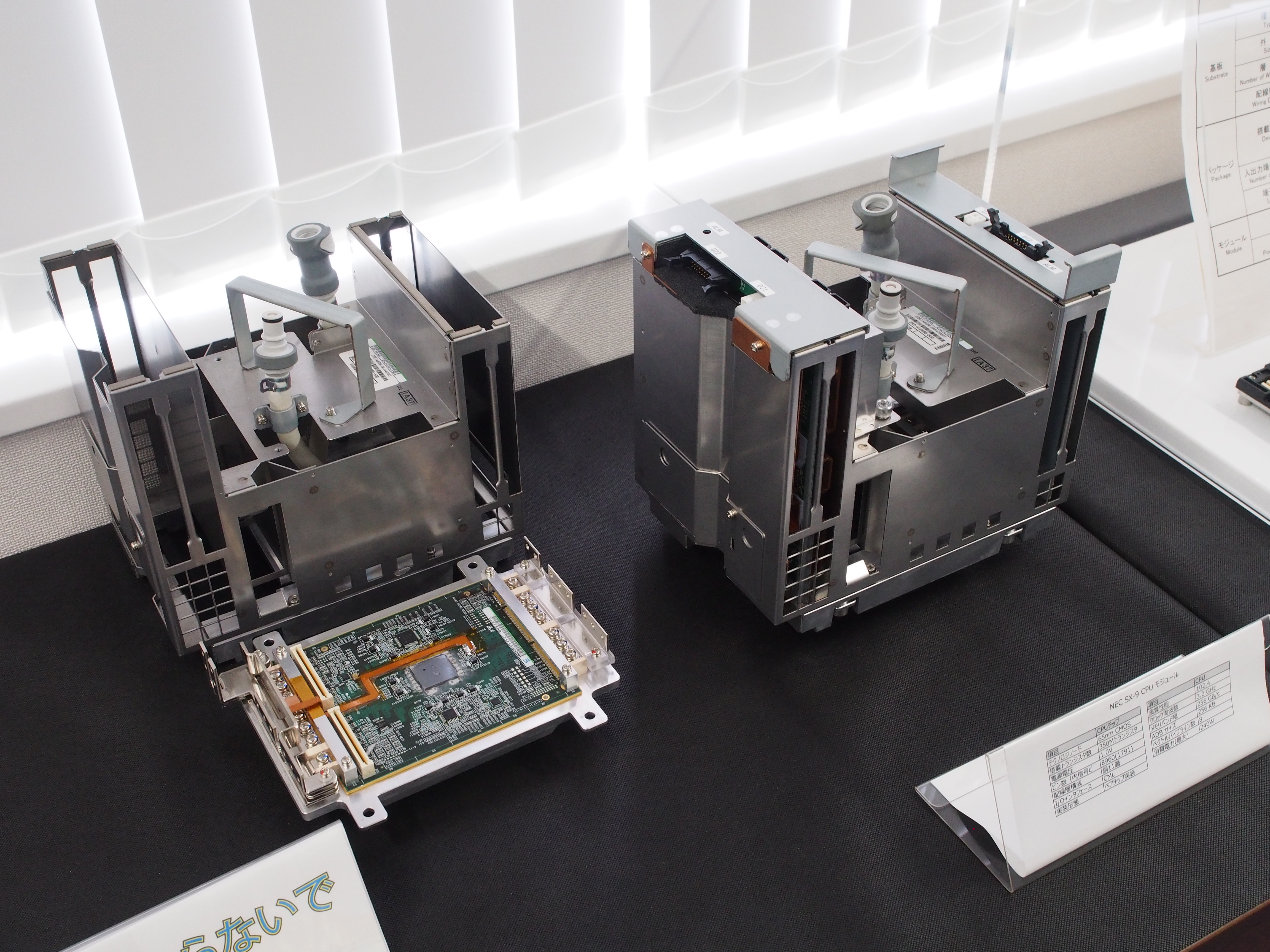SX-9 on:
[Wikipedia]
[Google]
[Amazon]




 The SX-9 is a NEC SX supercomputer built by
The SX-9 is a NEC SX supercomputer built by
TANAHASHI Toshio, TSUCHIDA Junichi, MATSUZAWA Hajime, NIWA Kenji, SATOH Tatsuo, KATAGIRI Masaru, NEC TECHNICAL JOURNAL, Vol.3, No.4, 2008 *Up to 16 CPUs per node, manufactured in 65 nm CMOS cu technology, 11 copper layers *Up to 64 GB of memory per CPU, 1 TB in a single node *Up to 4 TB/s bandwidth per node, 256 GB/s per CPU *IXS Super-Switch between nodes, up to 512 nodes supported, 256 GB/s per node (128 GB/s for each direction) *50% less power consumption compared to the NEC SX-8R
special issue of NEC Technical Journal (Vol 3, No 4, 2008) on NEC SX-9




 The SX-9 is a NEC SX supercomputer built by
The SX-9 is a NEC SX supercomputer built by NEC Corporation
is a Japanese multinational information technology and electronics corporation, headquartered in Minato, Tokyo. The company was known as the Nippon Electric Company, Limited, before rebranding in 1983 as NEC. It provides IT and network soluti ...
. The SX-9 Series implements an SMP
SMP may refer to:
Organisations
* Scale Model Products, 1950s, acquired by Aluminum Model Toys
* School Mathematics Project, UK developer of mathematics textbooks
* '' Sekolah Menengah Pertama'', "junior high school" in Indonesia
* Shanghai Mun ...
system in a compact node module and uses an enhanced version of the single chip vector processor that was introduced with the SX-6. The NEC SX-9 processors run at 3.2 GHz, with eight-way replicated vector pipes, each having two multiply units and two addition units; this results in a peak vector performance of 102.4 gigaFLOPS
In computing, floating point operations per second (FLOPS, flops or flop/s) is a measure of computer performance, useful in fields of scientific computations that require floating-point calculations. For such cases, it is a more accurate meas ...
. For non-vectorized code, there is a scalar processor that runs at half the speed of the vector unit, i.e. 1.6 GHz. Up to 16 CPUs and 1 terabyte of memory may be used in a single node. Each node is packaged in an air-cooled cabinet, similar in size to a standard 42U computer rack. The SX-9 series ranges from the single-node SX-9/B system with 4 CPUs to the maximum expansion stage with 512 nodes, 8,192 CPUs, and 970 TFLOPS peak performance. There is up to 4 TB/s shared memory bandwidth per node and 2×128 GB/s node interconnect bandwidth. The operating system is NEC's SUPER-UX, a Unix-like OS.
The SX-9 had the world's fastest vector CPU core. A fully equipped system with 512 nodes would have been the world's fastest supercomputer at the time of release in the first quarter of 2008, with a performance of 819 TFLOPS. The SX-9 was discontinued in 2015.
The German national meteorological service (DWD
The () or DWD for short, is the German Meteorological Service, based in Offenbach am Main, Germany, which monitors weather and meteorological conditions over Germany and provides weather services for the general public and for nautical, aviati ...
) operated two independent SX-9 clusters, with 976 processors, 31,232 GB of RAM and 98 TFLOPS performance in total.
NEC Published Product Highlights
*1.6 TFLOPS max. peak performance per node *350 million transistors per CPU, 1.0 V, 8,960 pins (1,791 signal pins)''LSI and Circuit Technologies of the SX-9''TANAHASHI Toshio, TSUCHIDA Junichi, MATSUZAWA Hajime, NIWA Kenji, SATOH Tatsuo, KATAGIRI Masaru, NEC TECHNICAL JOURNAL, Vol.3, No.4, 2008 *Up to 16 CPUs per node, manufactured in 65 nm CMOS cu technology, 11 copper layers *Up to 64 GB of memory per CPU, 1 TB in a single node *Up to 4 TB/s bandwidth per node, 256 GB/s per CPU *IXS Super-Switch between nodes, up to 512 nodes supported, 256 GB/s per node (128 GB/s for each direction) *50% less power consumption compared to the NEC SX-8R
See also
* SUPER-UX * SX architectureExternal links
special issue of NEC Technical Journal (Vol 3, No 4, 2008) on NEC SX-9
References
{{DEFAULTSORT:Nec Sx-9Sx-9
The SX-9 is a NEC SX supercomputer built by NEC Corporation. The SX-9 Series implements an SMP system in a compact node module and uses an enhanced version of the single chip vector processor that was introduced with the SX-6. The NEC SX-9 ...
Vector supercomputers
ja:NEC SX#SX-9